RMIT LAW2447 Commercial Law Team Paper: Negligence and Liability
VerifiedAdded on 2023/01/11
|12
|3479
|2
Report
AI Summary
This report provides a comprehensive analysis of commercial law principles, specifically focusing on negligence, duty of care, and vicarious liability through the examination of several case studies. The report delves into the application of legal rules, such as the establishment of duty of care, breach of duty, causation of injury, and the presence of contributory negligence. It explores the concept of vicarious liability, examining situations where employers may be held responsible for the actions of their employees. The report analyzes multiple scenarios, including incidents in supermarkets and workplaces, to determine liability and discuss potential defenses. Furthermore, the report highlights relevant legal precedents, such as Donoghue v Stevenson, Caparo Industries PLC v Dickman, and the application of the IRAC method (Issue, Rule, Application, Conclusion) to resolve complex legal issues. The analysis covers key aspects of tort law, including the elements of negligence, the relationship between parties, and the implications of actions by both the claimant and the defendant, culminating in conclusions regarding the outcomes of potential lawsuits.
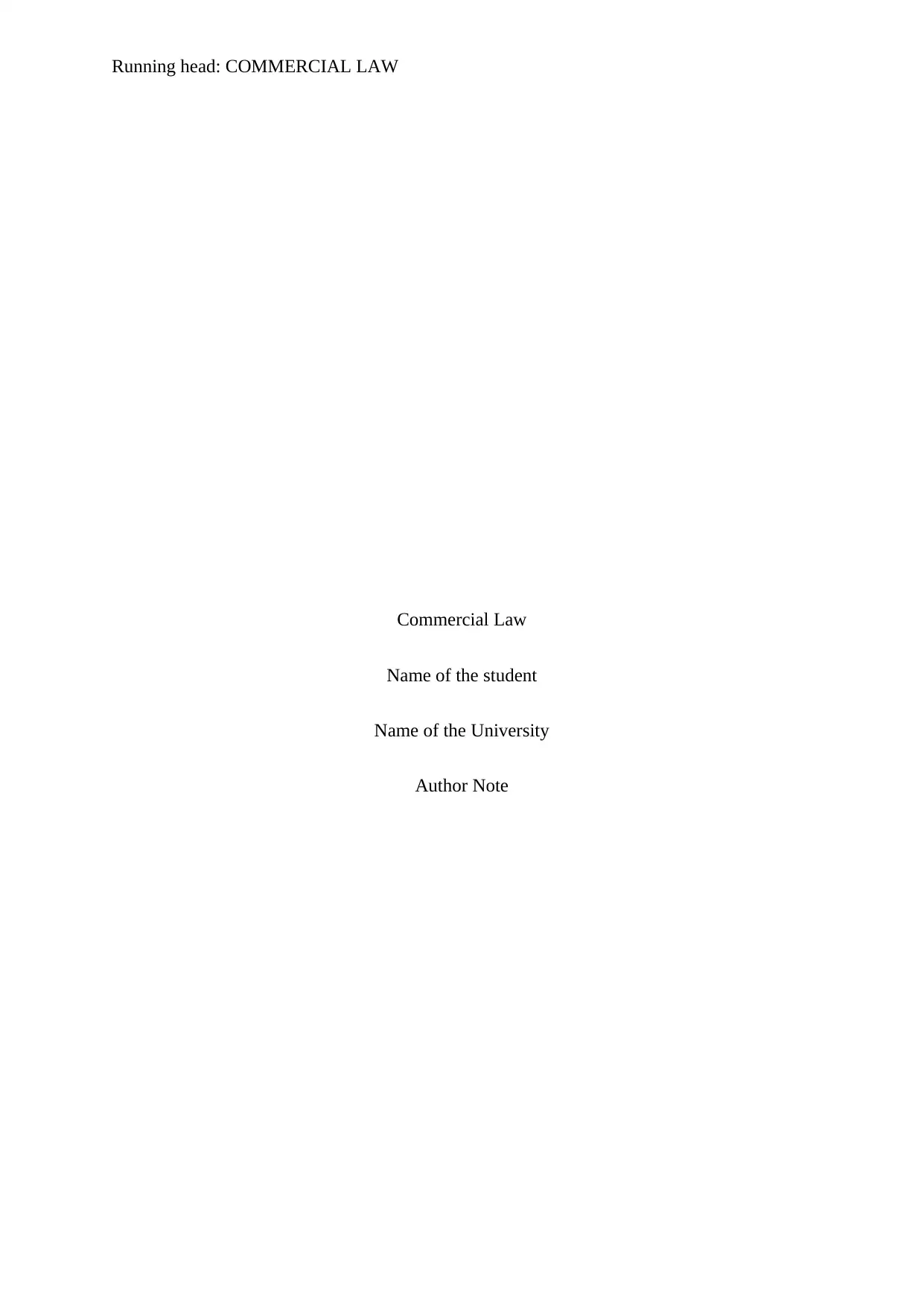
Running head: COMMERCIAL LAW
Commercial Law
Name of the student
Name of the University
Author Note
Commercial Law
Name of the student
Name of the University
Author Note
Paraphrase This Document
Need a fresh take? Get an instant paraphrase of this document with our AI Paraphraser
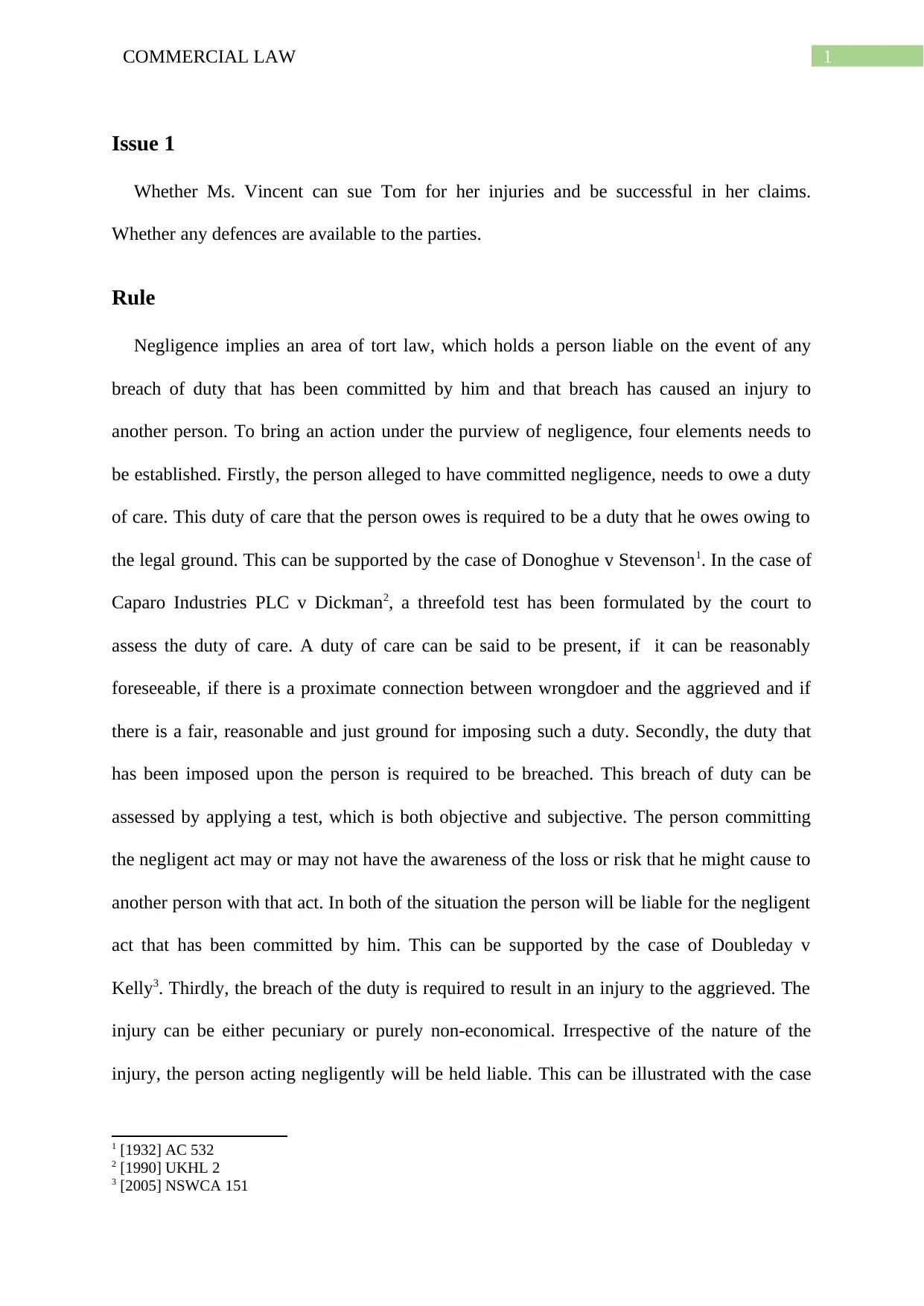
1COMMERCIAL LAW
Issue 1
Whether Ms. Vincent can sue Tom for her injuries and be successful in her claims.
Whether any defences are available to the parties.
Rule
Negligence implies an area of tort law, which holds a person liable on the event of any
breach of duty that has been committed by him and that breach has caused an injury to
another person. To bring an action under the purview of negligence, four elements needs to
be established. Firstly, the person alleged to have committed negligence, needs to owe a duty
of care. This duty of care that the person owes is required to be a duty that he owes owing to
the legal ground. This can be supported by the case of Donoghue v Stevenson1. In the case of
Caparo Industries PLC v Dickman2, a threefold test has been formulated by the court to
assess the duty of care. A duty of care can be said to be present, if it can be reasonably
foreseeable, if there is a proximate connection between wrongdoer and the aggrieved and if
there is a fair, reasonable and just ground for imposing such a duty. Secondly, the duty that
has been imposed upon the person is required to be breached. This breach of duty can be
assessed by applying a test, which is both objective and subjective. The person committing
the negligent act may or may not have the awareness of the loss or risk that he might cause to
another person with that act. In both of the situation the person will be liable for the negligent
act that has been committed by him. This can be supported by the case of Doubleday v
Kelly3. Thirdly, the breach of the duty is required to result in an injury to the aggrieved. The
injury can be either pecuniary or purely non-economical. Irrespective of the nature of the
injury, the person acting negligently will be held liable. This can be illustrated with the case
1 [1932] AC 532
2 [1990] UKHL 2
3 [2005] NSWCA 151
Issue 1
Whether Ms. Vincent can sue Tom for her injuries and be successful in her claims.
Whether any defences are available to the parties.
Rule
Negligence implies an area of tort law, which holds a person liable on the event of any
breach of duty that has been committed by him and that breach has caused an injury to
another person. To bring an action under the purview of negligence, four elements needs to
be established. Firstly, the person alleged to have committed negligence, needs to owe a duty
of care. This duty of care that the person owes is required to be a duty that he owes owing to
the legal ground. This can be supported by the case of Donoghue v Stevenson1. In the case of
Caparo Industries PLC v Dickman2, a threefold test has been formulated by the court to
assess the duty of care. A duty of care can be said to be present, if it can be reasonably
foreseeable, if there is a proximate connection between wrongdoer and the aggrieved and if
there is a fair, reasonable and just ground for imposing such a duty. Secondly, the duty that
has been imposed upon the person is required to be breached. This breach of duty can be
assessed by applying a test, which is both objective and subjective. The person committing
the negligent act may or may not have the awareness of the loss or risk that he might cause to
another person with that act. In both of the situation the person will be liable for the negligent
act that has been committed by him. This can be supported by the case of Doubleday v
Kelly3. Thirdly, the breach of the duty is required to result in an injury to the aggrieved. The
injury can be either pecuniary or purely non-economical. Irrespective of the nature of the
injury, the person acting negligently will be held liable. This can be illustrated with the case
1 [1932] AC 532
2 [1990] UKHL 2
3 [2005] NSWCA 151
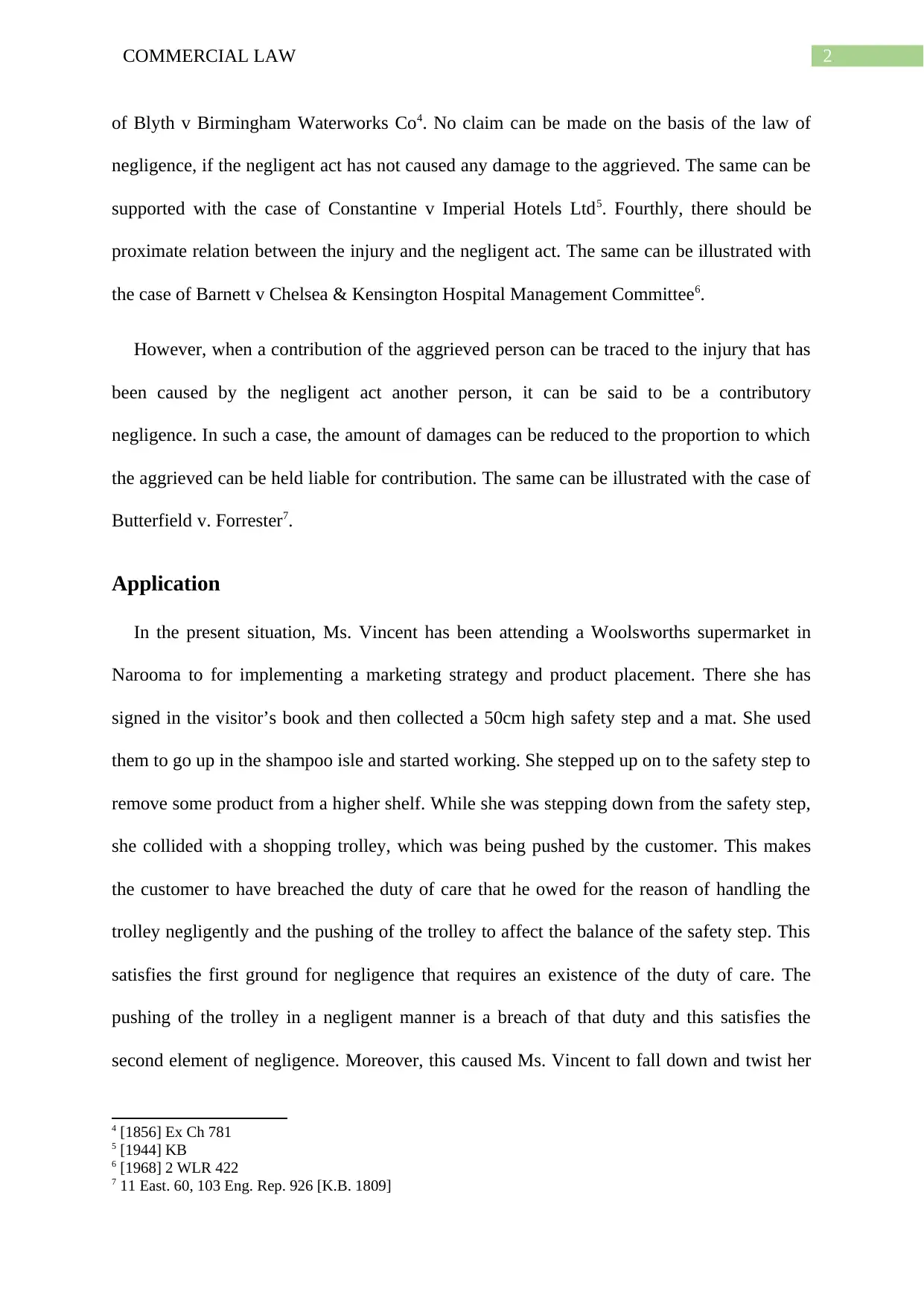
2COMMERCIAL LAW
of Blyth v Birmingham Waterworks Co4. No claim can be made on the basis of the law of
negligence, if the negligent act has not caused any damage to the aggrieved. The same can be
supported with the case of Constantine v Imperial Hotels Ltd5. Fourthly, there should be
proximate relation between the injury and the negligent act. The same can be illustrated with
the case of Barnett v Chelsea & Kensington Hospital Management Committee6.
However, when a contribution of the aggrieved person can be traced to the injury that has
been caused by the negligent act another person, it can be said to be a contributory
negligence. In such a case, the amount of damages can be reduced to the proportion to which
the aggrieved can be held liable for contribution. The same can be illustrated with the case of
Butterfield v. Forrester7.
Application
In the present situation, Ms. Vincent has been attending a Woolsworths supermarket in
Narooma to for implementing a marketing strategy and product placement. There she has
signed in the visitor’s book and then collected a 50cm high safety step and a mat. She used
them to go up in the shampoo isle and started working. She stepped up on to the safety step to
remove some product from a higher shelf. While she was stepping down from the safety step,
she collided with a shopping trolley, which was being pushed by the customer. This makes
the customer to have breached the duty of care that he owed for the reason of handling the
trolley negligently and the pushing of the trolley to affect the balance of the safety step. This
satisfies the first ground for negligence that requires an existence of the duty of care. The
pushing of the trolley in a negligent manner is a breach of that duty and this satisfies the
second element of negligence. Moreover, this caused Ms. Vincent to fall down and twist her
4 [1856] Ex Ch 781
5 [1944] KB
6 [1968] 2 WLR 422
7 11 East. 60, 103 Eng. Rep. 926 [K.B. 1809]
of Blyth v Birmingham Waterworks Co4. No claim can be made on the basis of the law of
negligence, if the negligent act has not caused any damage to the aggrieved. The same can be
supported with the case of Constantine v Imperial Hotels Ltd5. Fourthly, there should be
proximate relation between the injury and the negligent act. The same can be illustrated with
the case of Barnett v Chelsea & Kensington Hospital Management Committee6.
However, when a contribution of the aggrieved person can be traced to the injury that has
been caused by the negligent act another person, it can be said to be a contributory
negligence. In such a case, the amount of damages can be reduced to the proportion to which
the aggrieved can be held liable for contribution. The same can be illustrated with the case of
Butterfield v. Forrester7.
Application
In the present situation, Ms. Vincent has been attending a Woolsworths supermarket in
Narooma to for implementing a marketing strategy and product placement. There she has
signed in the visitor’s book and then collected a 50cm high safety step and a mat. She used
them to go up in the shampoo isle and started working. She stepped up on to the safety step to
remove some product from a higher shelf. While she was stepping down from the safety step,
she collided with a shopping trolley, which was being pushed by the customer. This makes
the customer to have breached the duty of care that he owed for the reason of handling the
trolley negligently and the pushing of the trolley to affect the balance of the safety step. This
satisfies the first ground for negligence that requires an existence of the duty of care. The
pushing of the trolley in a negligent manner is a breach of that duty and this satisfies the
second element of negligence. Moreover, this caused Ms. Vincent to fall down and twist her
4 [1856] Ex Ch 781
5 [1944] KB
6 [1968] 2 WLR 422
7 11 East. 60, 103 Eng. Rep. 926 [K.B. 1809]
⊘ This is a preview!⊘
Do you want full access?
Subscribe today to unlock all pages.

Trusted by 1+ million students worldwide
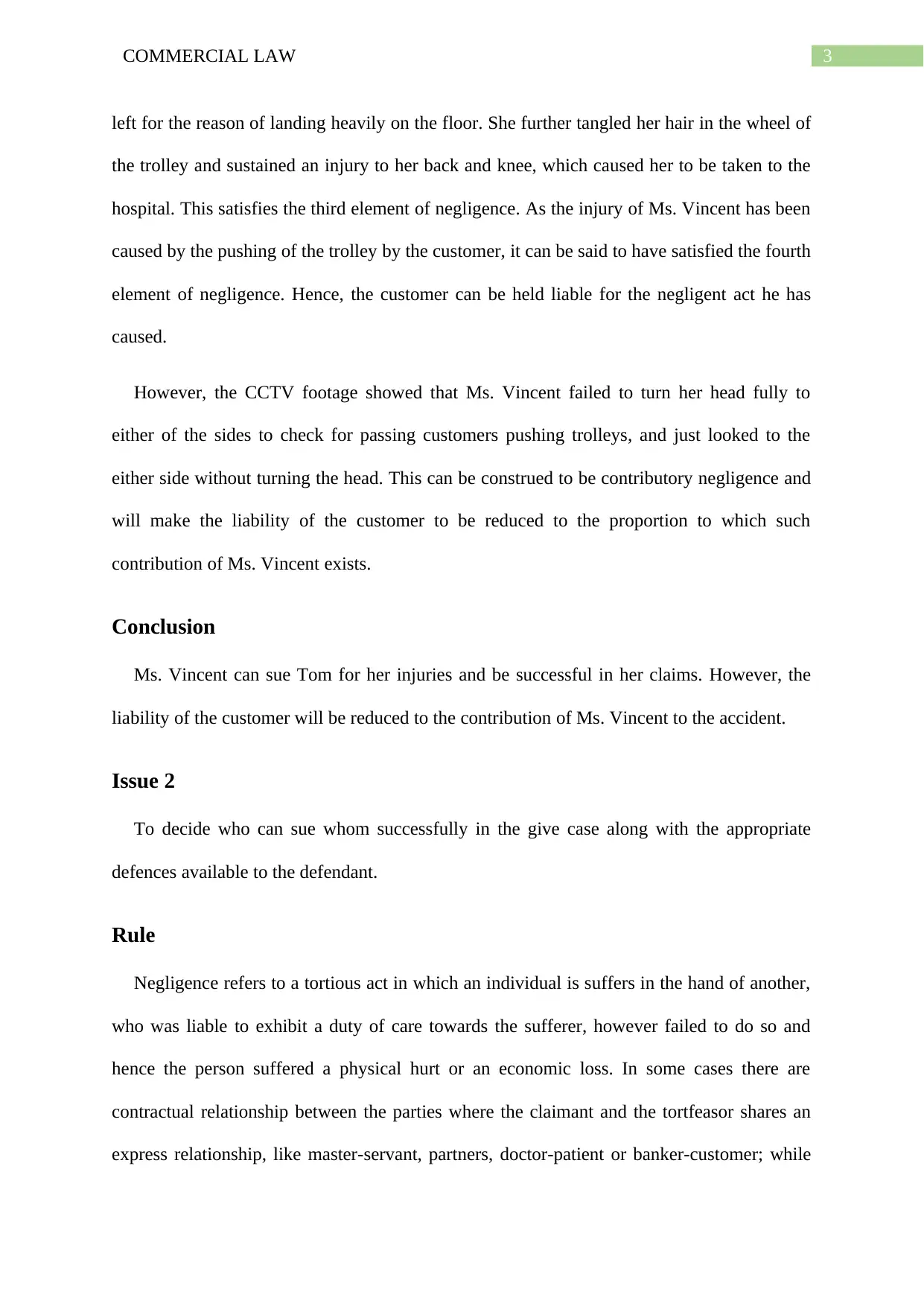
3COMMERCIAL LAW
left for the reason of landing heavily on the floor. She further tangled her hair in the wheel of
the trolley and sustained an injury to her back and knee, which caused her to be taken to the
hospital. This satisfies the third element of negligence. As the injury of Ms. Vincent has been
caused by the pushing of the trolley by the customer, it can be said to have satisfied the fourth
element of negligence. Hence, the customer can be held liable for the negligent act he has
caused.
However, the CCTV footage showed that Ms. Vincent failed to turn her head fully to
either of the sides to check for passing customers pushing trolleys, and just looked to the
either side without turning the head. This can be construed to be contributory negligence and
will make the liability of the customer to be reduced to the proportion to which such
contribution of Ms. Vincent exists.
Conclusion
Ms. Vincent can sue Tom for her injuries and be successful in her claims. However, the
liability of the customer will be reduced to the contribution of Ms. Vincent to the accident.
Issue 2
To decide who can sue whom successfully in the give case along with the appropriate
defences available to the defendant.
Rule
Negligence refers to a tortious act in which an individual is suffers in the hand of another,
who was liable to exhibit a duty of care towards the sufferer, however failed to do so and
hence the person suffered a physical hurt or an economic loss. In some cases there are
contractual relationship between the parties where the claimant and the tortfeasor shares an
express relationship, like master-servant, partners, doctor-patient or banker-customer; while
left for the reason of landing heavily on the floor. She further tangled her hair in the wheel of
the trolley and sustained an injury to her back and knee, which caused her to be taken to the
hospital. This satisfies the third element of negligence. As the injury of Ms. Vincent has been
caused by the pushing of the trolley by the customer, it can be said to have satisfied the fourth
element of negligence. Hence, the customer can be held liable for the negligent act he has
caused.
However, the CCTV footage showed that Ms. Vincent failed to turn her head fully to
either of the sides to check for passing customers pushing trolleys, and just looked to the
either side without turning the head. This can be construed to be contributory negligence and
will make the liability of the customer to be reduced to the proportion to which such
contribution of Ms. Vincent exists.
Conclusion
Ms. Vincent can sue Tom for her injuries and be successful in her claims. However, the
liability of the customer will be reduced to the contribution of Ms. Vincent to the accident.
Issue 2
To decide who can sue whom successfully in the give case along with the appropriate
defences available to the defendant.
Rule
Negligence refers to a tortious act in which an individual is suffers in the hand of another,
who was liable to exhibit a duty of care towards the sufferer, however failed to do so and
hence the person suffered a physical hurt or an economic loss. In some cases there are
contractual relationship between the parties where the claimant and the tortfeasor shares an
express relationship, like master-servant, partners, doctor-patient or banker-customer; while
Paraphrase This Document
Need a fresh take? Get an instant paraphrase of this document with our AI Paraphraser
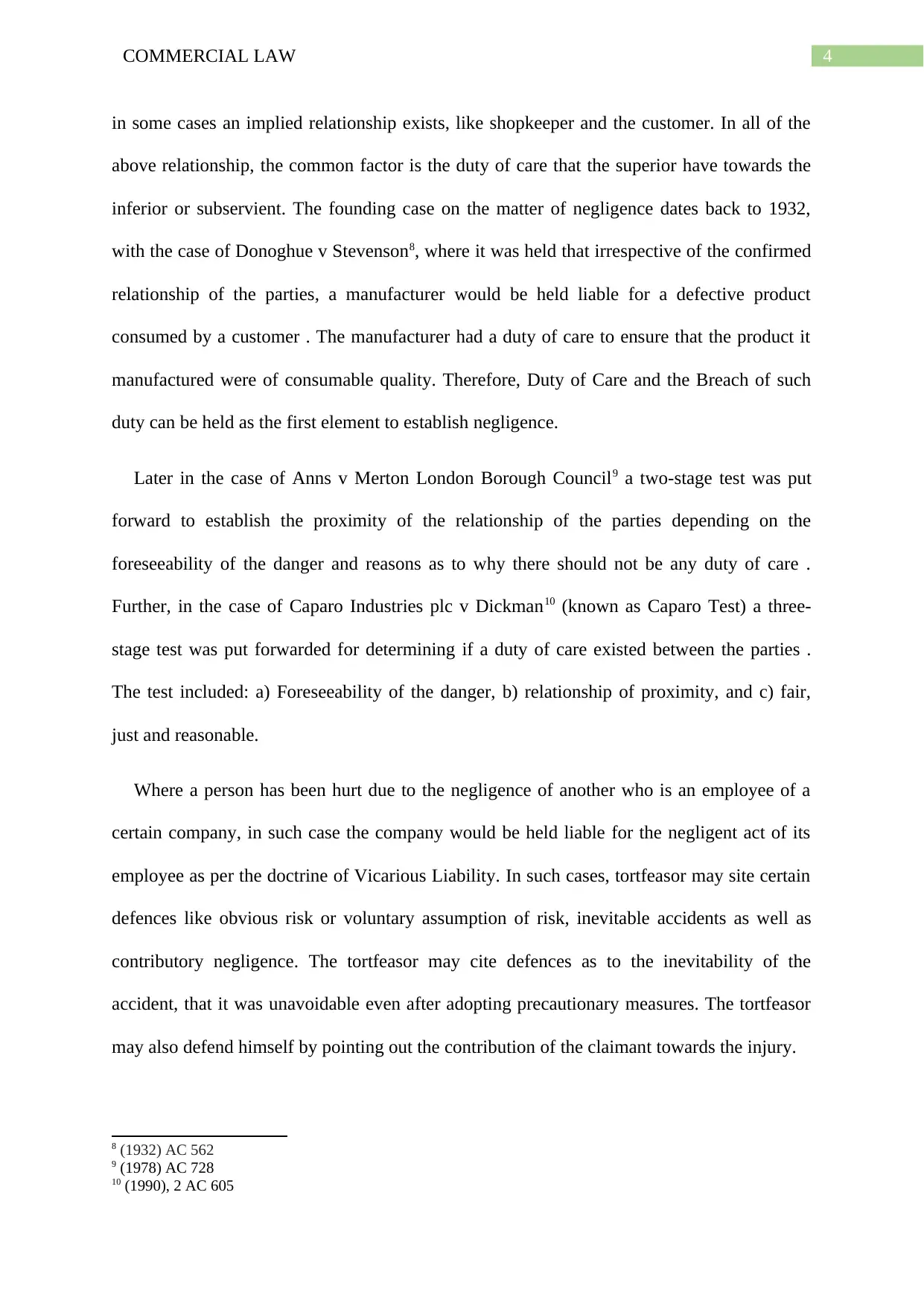
4COMMERCIAL LAW
in some cases an implied relationship exists, like shopkeeper and the customer. In all of the
above relationship, the common factor is the duty of care that the superior have towards the
inferior or subservient. The founding case on the matter of negligence dates back to 1932,
with the case of Donoghue v Stevenson8, where it was held that irrespective of the confirmed
relationship of the parties, a manufacturer would be held liable for a defective product
consumed by a customer . The manufacturer had a duty of care to ensure that the product it
manufactured were of consumable quality. Therefore, Duty of Care and the Breach of such
duty can be held as the first element to establish negligence.
Later in the case of Anns v Merton London Borough Council9 a two-stage test was put
forward to establish the proximity of the relationship of the parties depending on the
foreseeability of the danger and reasons as to why there should not be any duty of care .
Further, in the case of Caparo Industries plc v Dickman10 (known as Caparo Test) a three-
stage test was put forwarded for determining if a duty of care existed between the parties .
The test included: a) Foreseeability of the danger, b) relationship of proximity, and c) fair,
just and reasonable.
Where a person has been hurt due to the negligence of another who is an employee of a
certain company, in such case the company would be held liable for the negligent act of its
employee as per the doctrine of Vicarious Liability. In such cases, tortfeasor may site certain
defences like obvious risk or voluntary assumption of risk, inevitable accidents as well as
contributory negligence. The tortfeasor may cite defences as to the inevitability of the
accident, that it was unavoidable even after adopting precautionary measures. The tortfeasor
may also defend himself by pointing out the contribution of the claimant towards the injury.
8 (1932) AC 562
9 (1978) AC 728
10 (1990), 2 AC 605
in some cases an implied relationship exists, like shopkeeper and the customer. In all of the
above relationship, the common factor is the duty of care that the superior have towards the
inferior or subservient. The founding case on the matter of negligence dates back to 1932,
with the case of Donoghue v Stevenson8, where it was held that irrespective of the confirmed
relationship of the parties, a manufacturer would be held liable for a defective product
consumed by a customer . The manufacturer had a duty of care to ensure that the product it
manufactured were of consumable quality. Therefore, Duty of Care and the Breach of such
duty can be held as the first element to establish negligence.
Later in the case of Anns v Merton London Borough Council9 a two-stage test was put
forward to establish the proximity of the relationship of the parties depending on the
foreseeability of the danger and reasons as to why there should not be any duty of care .
Further, in the case of Caparo Industries plc v Dickman10 (known as Caparo Test) a three-
stage test was put forwarded for determining if a duty of care existed between the parties .
The test included: a) Foreseeability of the danger, b) relationship of proximity, and c) fair,
just and reasonable.
Where a person has been hurt due to the negligence of another who is an employee of a
certain company, in such case the company would be held liable for the negligent act of its
employee as per the doctrine of Vicarious Liability. In such cases, tortfeasor may site certain
defences like obvious risk or voluntary assumption of risk, inevitable accidents as well as
contributory negligence. The tortfeasor may cite defences as to the inevitability of the
accident, that it was unavoidable even after adopting precautionary measures. The tortfeasor
may also defend himself by pointing out the contribution of the claimant towards the injury.
8 (1932) AC 562
9 (1978) AC 728
10 (1990), 2 AC 605
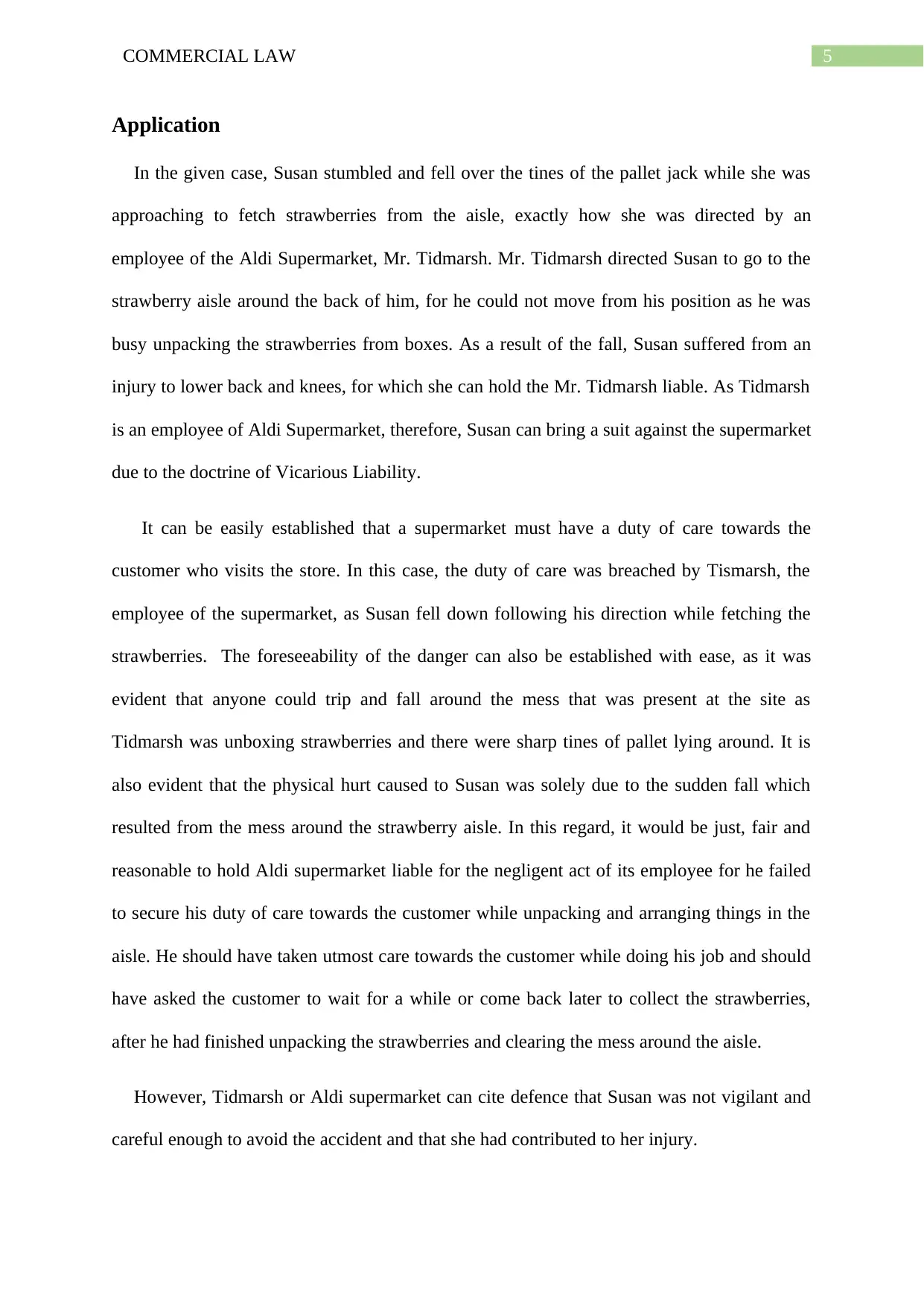
5COMMERCIAL LAW
Application
In the given case, Susan stumbled and fell over the tines of the pallet jack while she was
approaching to fetch strawberries from the aisle, exactly how she was directed by an
employee of the Aldi Supermarket, Mr. Tidmarsh. Mr. Tidmarsh directed Susan to go to the
strawberry aisle around the back of him, for he could not move from his position as he was
busy unpacking the strawberries from boxes. As a result of the fall, Susan suffered from an
injury to lower back and knees, for which she can hold the Mr. Tidmarsh liable. As Tidmarsh
is an employee of Aldi Supermarket, therefore, Susan can bring a suit against the supermarket
due to the doctrine of Vicarious Liability.
It can be easily established that a supermarket must have a duty of care towards the
customer who visits the store. In this case, the duty of care was breached by Tismarsh, the
employee of the supermarket, as Susan fell down following his direction while fetching the
strawberries. The foreseeability of the danger can also be established with ease, as it was
evident that anyone could trip and fall around the mess that was present at the site as
Tidmarsh was unboxing strawberries and there were sharp tines of pallet lying around. It is
also evident that the physical hurt caused to Susan was solely due to the sudden fall which
resulted from the mess around the strawberry aisle. In this regard, it would be just, fair and
reasonable to hold Aldi supermarket liable for the negligent act of its employee for he failed
to secure his duty of care towards the customer while unpacking and arranging things in the
aisle. He should have taken utmost care towards the customer while doing his job and should
have asked the customer to wait for a while or come back later to collect the strawberries,
after he had finished unpacking the strawberries and clearing the mess around the aisle.
However, Tidmarsh or Aldi supermarket can cite defence that Susan was not vigilant and
careful enough to avoid the accident and that she had contributed to her injury.
Application
In the given case, Susan stumbled and fell over the tines of the pallet jack while she was
approaching to fetch strawberries from the aisle, exactly how she was directed by an
employee of the Aldi Supermarket, Mr. Tidmarsh. Mr. Tidmarsh directed Susan to go to the
strawberry aisle around the back of him, for he could not move from his position as he was
busy unpacking the strawberries from boxes. As a result of the fall, Susan suffered from an
injury to lower back and knees, for which she can hold the Mr. Tidmarsh liable. As Tidmarsh
is an employee of Aldi Supermarket, therefore, Susan can bring a suit against the supermarket
due to the doctrine of Vicarious Liability.
It can be easily established that a supermarket must have a duty of care towards the
customer who visits the store. In this case, the duty of care was breached by Tismarsh, the
employee of the supermarket, as Susan fell down following his direction while fetching the
strawberries. The foreseeability of the danger can also be established with ease, as it was
evident that anyone could trip and fall around the mess that was present at the site as
Tidmarsh was unboxing strawberries and there were sharp tines of pallet lying around. It is
also evident that the physical hurt caused to Susan was solely due to the sudden fall which
resulted from the mess around the strawberry aisle. In this regard, it would be just, fair and
reasonable to hold Aldi supermarket liable for the negligent act of its employee for he failed
to secure his duty of care towards the customer while unpacking and arranging things in the
aisle. He should have taken utmost care towards the customer while doing his job and should
have asked the customer to wait for a while or come back later to collect the strawberries,
after he had finished unpacking the strawberries and clearing the mess around the aisle.
However, Tidmarsh or Aldi supermarket can cite defence that Susan was not vigilant and
careful enough to avoid the accident and that she had contributed to her injury.
⊘ This is a preview!⊘
Do you want full access?
Subscribe today to unlock all pages.

Trusted by 1+ million students worldwide
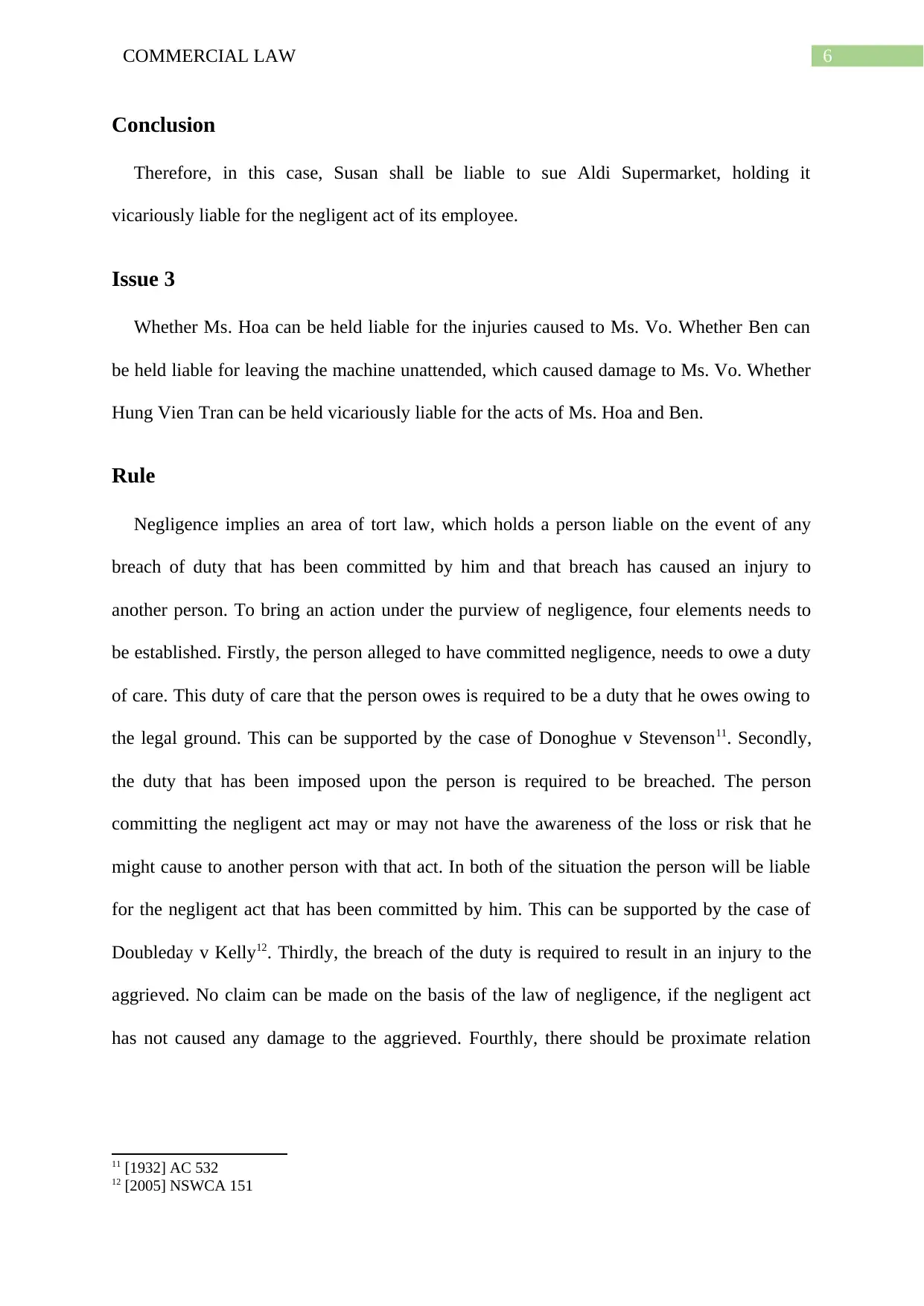
6COMMERCIAL LAW
Conclusion
Therefore, in this case, Susan shall be liable to sue Aldi Supermarket, holding it
vicariously liable for the negligent act of its employee.
Issue 3
Whether Ms. Hoa can be held liable for the injuries caused to Ms. Vo. Whether Ben can
be held liable for leaving the machine unattended, which caused damage to Ms. Vo. Whether
Hung Vien Tran can be held vicariously liable for the acts of Ms. Hoa and Ben.
Rule
Negligence implies an area of tort law, which holds a person liable on the event of any
breach of duty that has been committed by him and that breach has caused an injury to
another person. To bring an action under the purview of negligence, four elements needs to
be established. Firstly, the person alleged to have committed negligence, needs to owe a duty
of care. This duty of care that the person owes is required to be a duty that he owes owing to
the legal ground. This can be supported by the case of Donoghue v Stevenson11. Secondly,
the duty that has been imposed upon the person is required to be breached. The person
committing the negligent act may or may not have the awareness of the loss or risk that he
might cause to another person with that act. In both of the situation the person will be liable
for the negligent act that has been committed by him. This can be supported by the case of
Doubleday v Kelly12. Thirdly, the breach of the duty is required to result in an injury to the
aggrieved. No claim can be made on the basis of the law of negligence, if the negligent act
has not caused any damage to the aggrieved. Fourthly, there should be proximate relation
11 [1932] AC 532
12 [2005] NSWCA 151
Conclusion
Therefore, in this case, Susan shall be liable to sue Aldi Supermarket, holding it
vicariously liable for the negligent act of its employee.
Issue 3
Whether Ms. Hoa can be held liable for the injuries caused to Ms. Vo. Whether Ben can
be held liable for leaving the machine unattended, which caused damage to Ms. Vo. Whether
Hung Vien Tran can be held vicariously liable for the acts of Ms. Hoa and Ben.
Rule
Negligence implies an area of tort law, which holds a person liable on the event of any
breach of duty that has been committed by him and that breach has caused an injury to
another person. To bring an action under the purview of negligence, four elements needs to
be established. Firstly, the person alleged to have committed negligence, needs to owe a duty
of care. This duty of care that the person owes is required to be a duty that he owes owing to
the legal ground. This can be supported by the case of Donoghue v Stevenson11. Secondly,
the duty that has been imposed upon the person is required to be breached. The person
committing the negligent act may or may not have the awareness of the loss or risk that he
might cause to another person with that act. In both of the situation the person will be liable
for the negligent act that has been committed by him. This can be supported by the case of
Doubleday v Kelly12. Thirdly, the breach of the duty is required to result in an injury to the
aggrieved. No claim can be made on the basis of the law of negligence, if the negligent act
has not caused any damage to the aggrieved. Fourthly, there should be proximate relation
11 [1932] AC 532
12 [2005] NSWCA 151
Paraphrase This Document
Need a fresh take? Get an instant paraphrase of this document with our AI Paraphraser
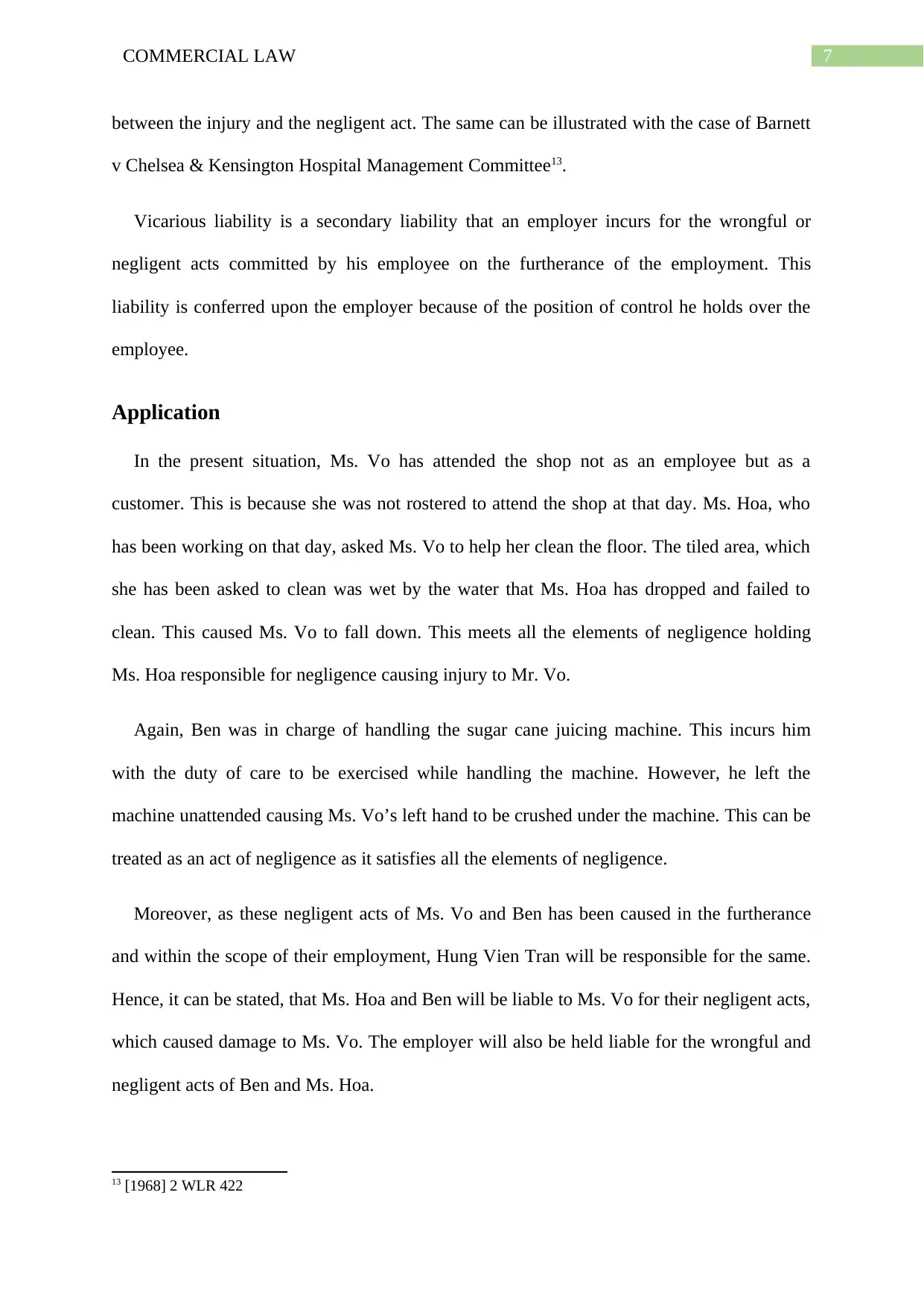
7COMMERCIAL LAW
between the injury and the negligent act. The same can be illustrated with the case of Barnett
v Chelsea & Kensington Hospital Management Committee13.
Vicarious liability is a secondary liability that an employer incurs for the wrongful or
negligent acts committed by his employee on the furtherance of the employment. This
liability is conferred upon the employer because of the position of control he holds over the
employee.
Application
In the present situation, Ms. Vo has attended the shop not as an employee but as a
customer. This is because she was not rostered to attend the shop at that day. Ms. Hoa, who
has been working on that day, asked Ms. Vo to help her clean the floor. The tiled area, which
she has been asked to clean was wet by the water that Ms. Hoa has dropped and failed to
clean. This caused Ms. Vo to fall down. This meets all the elements of negligence holding
Ms. Hoa responsible for negligence causing injury to Mr. Vo.
Again, Ben was in charge of handling the sugar cane juicing machine. This incurs him
with the duty of care to be exercised while handling the machine. However, he left the
machine unattended causing Ms. Vo’s left hand to be crushed under the machine. This can be
treated as an act of negligence as it satisfies all the elements of negligence.
Moreover, as these negligent acts of Ms. Vo and Ben has been caused in the furtherance
and within the scope of their employment, Hung Vien Tran will be responsible for the same.
Hence, it can be stated, that Ms. Hoa and Ben will be liable to Ms. Vo for their negligent acts,
which caused damage to Ms. Vo. The employer will also be held liable for the wrongful and
negligent acts of Ben and Ms. Hoa.
13 [1968] 2 WLR 422
between the injury and the negligent act. The same can be illustrated with the case of Barnett
v Chelsea & Kensington Hospital Management Committee13.
Vicarious liability is a secondary liability that an employer incurs for the wrongful or
negligent acts committed by his employee on the furtherance of the employment. This
liability is conferred upon the employer because of the position of control he holds over the
employee.
Application
In the present situation, Ms. Vo has attended the shop not as an employee but as a
customer. This is because she was not rostered to attend the shop at that day. Ms. Hoa, who
has been working on that day, asked Ms. Vo to help her clean the floor. The tiled area, which
she has been asked to clean was wet by the water that Ms. Hoa has dropped and failed to
clean. This caused Ms. Vo to fall down. This meets all the elements of negligence holding
Ms. Hoa responsible for negligence causing injury to Mr. Vo.
Again, Ben was in charge of handling the sugar cane juicing machine. This incurs him
with the duty of care to be exercised while handling the machine. However, he left the
machine unattended causing Ms. Vo’s left hand to be crushed under the machine. This can be
treated as an act of negligence as it satisfies all the elements of negligence.
Moreover, as these negligent acts of Ms. Vo and Ben has been caused in the furtherance
and within the scope of their employment, Hung Vien Tran will be responsible for the same.
Hence, it can be stated, that Ms. Hoa and Ben will be liable to Ms. Vo for their negligent acts,
which caused damage to Ms. Vo. The employer will also be held liable for the wrongful and
negligent acts of Ben and Ms. Hoa.
13 [1968] 2 WLR 422
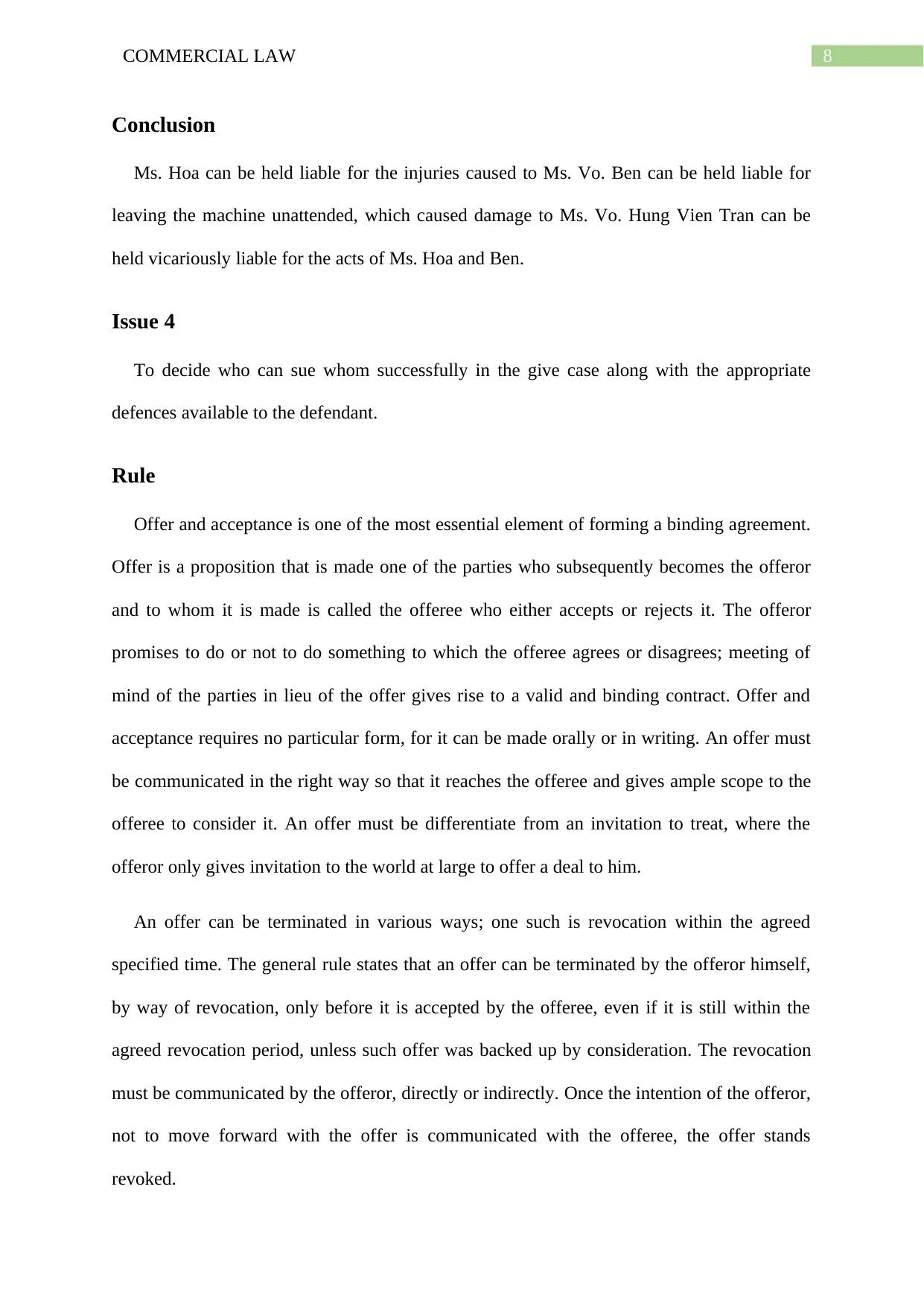
8COMMERCIAL LAW
Conclusion
Ms. Hoa can be held liable for the injuries caused to Ms. Vo. Ben can be held liable for
leaving the machine unattended, which caused damage to Ms. Vo. Hung Vien Tran can be
held vicariously liable for the acts of Ms. Hoa and Ben.
Issue 4
To decide who can sue whom successfully in the give case along with the appropriate
defences available to the defendant.
Rule
Offer and acceptance is one of the most essential element of forming a binding agreement.
Offer is a proposition that is made one of the parties who subsequently becomes the offeror
and to whom it is made is called the offeree who either accepts or rejects it. The offeror
promises to do or not to do something to which the offeree agrees or disagrees; meeting of
mind of the parties in lieu of the offer gives rise to a valid and binding contract. Offer and
acceptance requires no particular form, for it can be made orally or in writing. An offer must
be communicated in the right way so that it reaches the offeree and gives ample scope to the
offeree to consider it. An offer must be differentiate from an invitation to treat, where the
offeror only gives invitation to the world at large to offer a deal to him.
An offer can be terminated in various ways; one such is revocation within the agreed
specified time. The general rule states that an offer can be terminated by the offeror himself,
by way of revocation, only before it is accepted by the offeree, even if it is still within the
agreed revocation period, unless such offer was backed up by consideration. The revocation
must be communicated by the offeror, directly or indirectly. Once the intention of the offeror,
not to move forward with the offer is communicated with the offeree, the offer stands
revoked.
Conclusion
Ms. Hoa can be held liable for the injuries caused to Ms. Vo. Ben can be held liable for
leaving the machine unattended, which caused damage to Ms. Vo. Hung Vien Tran can be
held vicariously liable for the acts of Ms. Hoa and Ben.
Issue 4
To decide who can sue whom successfully in the give case along with the appropriate
defences available to the defendant.
Rule
Offer and acceptance is one of the most essential element of forming a binding agreement.
Offer is a proposition that is made one of the parties who subsequently becomes the offeror
and to whom it is made is called the offeree who either accepts or rejects it. The offeror
promises to do or not to do something to which the offeree agrees or disagrees; meeting of
mind of the parties in lieu of the offer gives rise to a valid and binding contract. Offer and
acceptance requires no particular form, for it can be made orally or in writing. An offer must
be communicated in the right way so that it reaches the offeree and gives ample scope to the
offeree to consider it. An offer must be differentiate from an invitation to treat, where the
offeror only gives invitation to the world at large to offer a deal to him.
An offer can be terminated in various ways; one such is revocation within the agreed
specified time. The general rule states that an offer can be terminated by the offeror himself,
by way of revocation, only before it is accepted by the offeree, even if it is still within the
agreed revocation period, unless such offer was backed up by consideration. The revocation
must be communicated by the offeror, directly or indirectly. Once the intention of the offeror,
not to move forward with the offer is communicated with the offeree, the offer stands
revoked.
⊘ This is a preview!⊘
Do you want full access?
Subscribe today to unlock all pages.

Trusted by 1+ million students worldwide
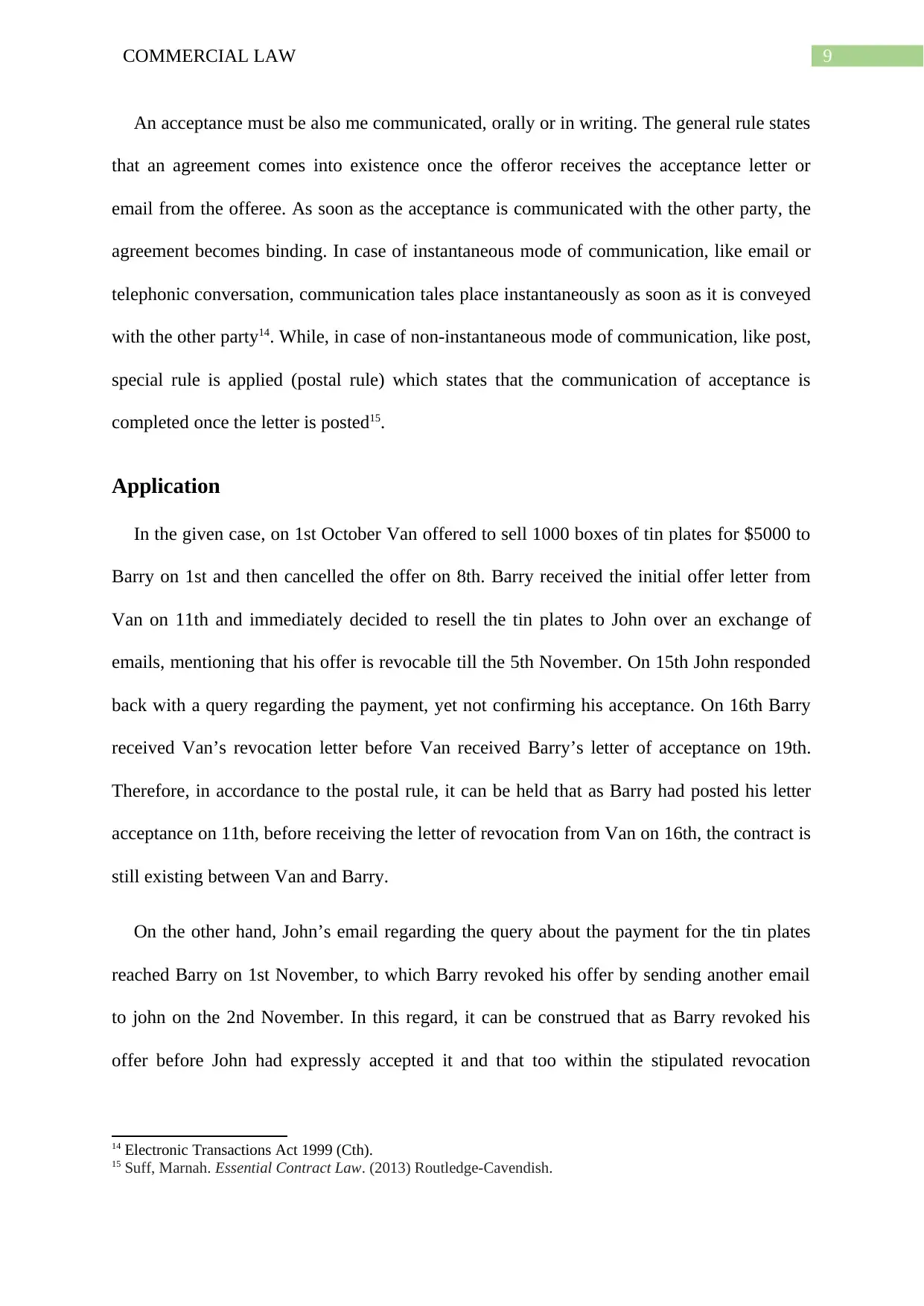
9COMMERCIAL LAW
An acceptance must be also me communicated, orally or in writing. The general rule states
that an agreement comes into existence once the offeror receives the acceptance letter or
email from the offeree. As soon as the acceptance is communicated with the other party, the
agreement becomes binding. In case of instantaneous mode of communication, like email or
telephonic conversation, communication tales place instantaneously as soon as it is conveyed
with the other party14. While, in case of non-instantaneous mode of communication, like post,
special rule is applied (postal rule) which states that the communication of acceptance is
completed once the letter is posted15.
Application
In the given case, on 1st October Van offered to sell 1000 boxes of tin plates for $5000 to
Barry on 1st and then cancelled the offer on 8th. Barry received the initial offer letter from
Van on 11th and immediately decided to resell the tin plates to John over an exchange of
emails, mentioning that his offer is revocable till the 5th November. On 15th John responded
back with a query regarding the payment, yet not confirming his acceptance. On 16th Barry
received Van’s revocation letter before Van received Barry’s letter of acceptance on 19th.
Therefore, in accordance to the postal rule, it can be held that as Barry had posted his letter
acceptance on 11th, before receiving the letter of revocation from Van on 16th, the contract is
still existing between Van and Barry.
On the other hand, John’s email regarding the query about the payment for the tin plates
reached Barry on 1st November, to which Barry revoked his offer by sending another email
to john on the 2nd November. In this regard, it can be construed that as Barry revoked his
offer before John had expressly accepted it and that too within the stipulated revocation
14 Electronic Transactions Act 1999 (Cth).
15 Suff, Marnah. Essential Contract Law. (2013) Routledge-Cavendish.
An acceptance must be also me communicated, orally or in writing. The general rule states
that an agreement comes into existence once the offeror receives the acceptance letter or
email from the offeree. As soon as the acceptance is communicated with the other party, the
agreement becomes binding. In case of instantaneous mode of communication, like email or
telephonic conversation, communication tales place instantaneously as soon as it is conveyed
with the other party14. While, in case of non-instantaneous mode of communication, like post,
special rule is applied (postal rule) which states that the communication of acceptance is
completed once the letter is posted15.
Application
In the given case, on 1st October Van offered to sell 1000 boxes of tin plates for $5000 to
Barry on 1st and then cancelled the offer on 8th. Barry received the initial offer letter from
Van on 11th and immediately decided to resell the tin plates to John over an exchange of
emails, mentioning that his offer is revocable till the 5th November. On 15th John responded
back with a query regarding the payment, yet not confirming his acceptance. On 16th Barry
received Van’s revocation letter before Van received Barry’s letter of acceptance on 19th.
Therefore, in accordance to the postal rule, it can be held that as Barry had posted his letter
acceptance on 11th, before receiving the letter of revocation from Van on 16th, the contract is
still existing between Van and Barry.
On the other hand, John’s email regarding the query about the payment for the tin plates
reached Barry on 1st November, to which Barry revoked his offer by sending another email
to john on the 2nd November. In this regard, it can be construed that as Barry revoked his
offer before John had expressly accepted it and that too within the stipulated revocation
14 Electronic Transactions Act 1999 (Cth).
15 Suff, Marnah. Essential Contract Law. (2013) Routledge-Cavendish.
Paraphrase This Document
Need a fresh take? Get an instant paraphrase of this document with our AI Paraphraser
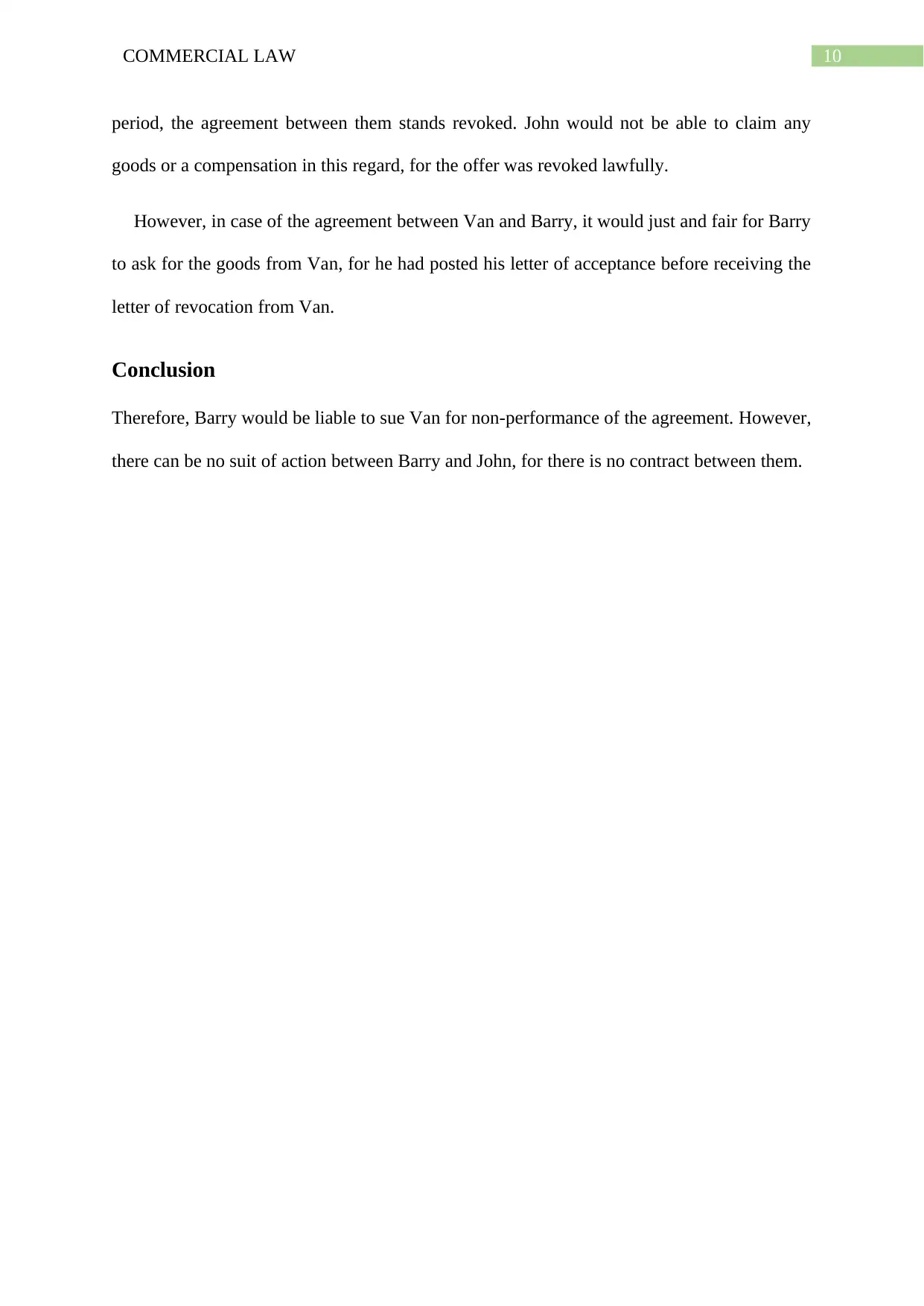
10COMMERCIAL LAW
period, the agreement between them stands revoked. John would not be able to claim any
goods or a compensation in this regard, for the offer was revoked lawfully.
However, in case of the agreement between Van and Barry, it would just and fair for Barry
to ask for the goods from Van, for he had posted his letter of acceptance before receiving the
letter of revocation from Van.
Conclusion
Therefore, Barry would be liable to sue Van for non-performance of the agreement. However,
there can be no suit of action between Barry and John, for there is no contract between them.
period, the agreement between them stands revoked. John would not be able to claim any
goods or a compensation in this regard, for the offer was revoked lawfully.
However, in case of the agreement between Van and Barry, it would just and fair for Barry
to ask for the goods from Van, for he had posted his letter of acceptance before receiving the
letter of revocation from Van.
Conclusion
Therefore, Barry would be liable to sue Van for non-performance of the agreement. However,
there can be no suit of action between Barry and John, for there is no contract between them.
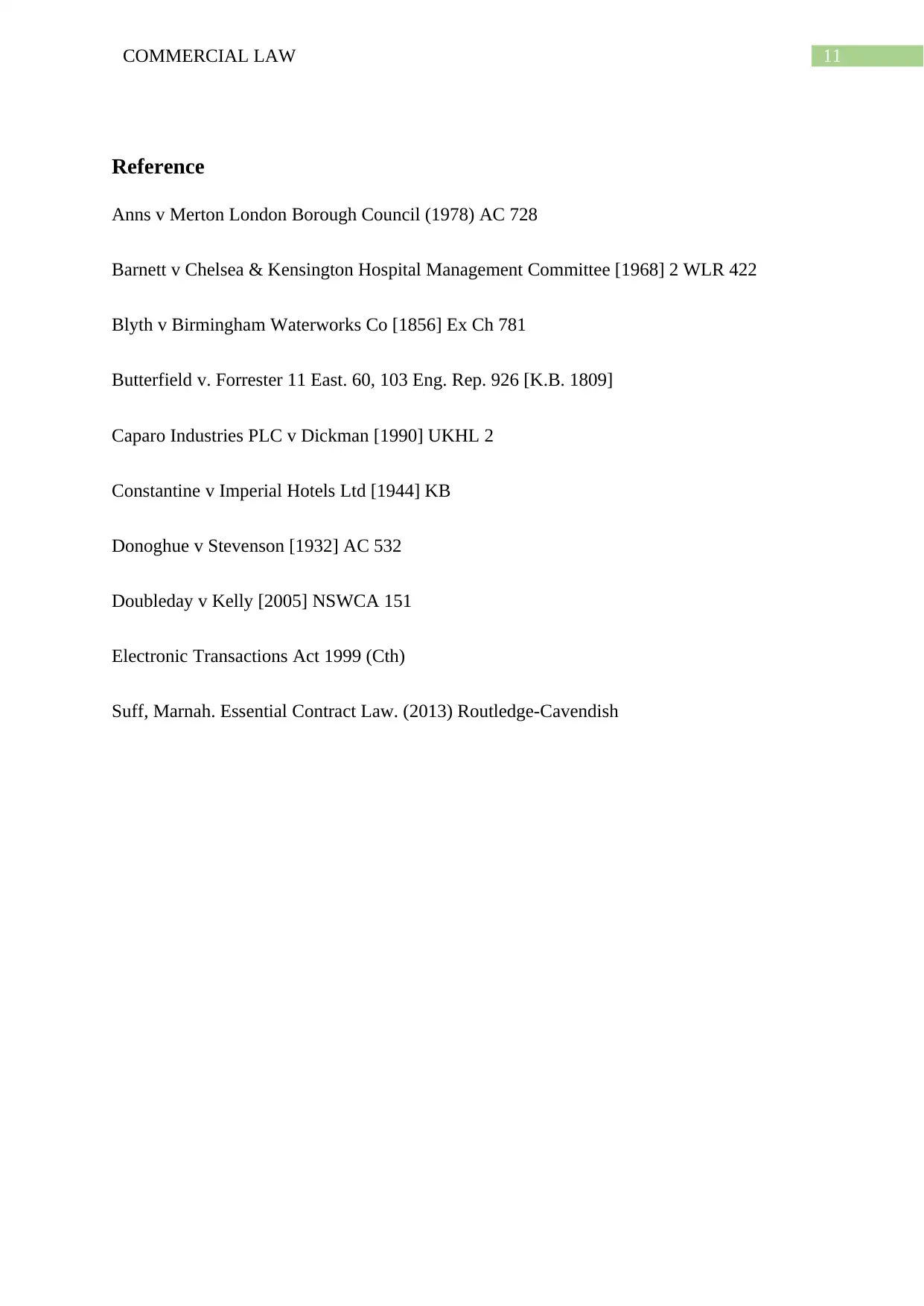
11COMMERCIAL LAW
Reference
Anns v Merton London Borough Council (1978) AC 728
Barnett v Chelsea & Kensington Hospital Management Committee [1968] 2 WLR 422
Blyth v Birmingham Waterworks Co [1856] Ex Ch 781
Butterfield v. Forrester 11 East. 60, 103 Eng. Rep. 926 [K.B. 1809]
Caparo Industries PLC v Dickman [1990] UKHL 2
Constantine v Imperial Hotels Ltd [1944] KB
Donoghue v Stevenson [1932] AC 532
Doubleday v Kelly [2005] NSWCA 151
Electronic Transactions Act 1999 (Cth)
Suff, Marnah. Essential Contract Law. (2013) Routledge-Cavendish
Reference
Anns v Merton London Borough Council (1978) AC 728
Barnett v Chelsea & Kensington Hospital Management Committee [1968] 2 WLR 422
Blyth v Birmingham Waterworks Co [1856] Ex Ch 781
Butterfield v. Forrester 11 East. 60, 103 Eng. Rep. 926 [K.B. 1809]
Caparo Industries PLC v Dickman [1990] UKHL 2
Constantine v Imperial Hotels Ltd [1944] KB
Donoghue v Stevenson [1932] AC 532
Doubleday v Kelly [2005] NSWCA 151
Electronic Transactions Act 1999 (Cth)
Suff, Marnah. Essential Contract Law. (2013) Routledge-Cavendish
⊘ This is a preview!⊘
Do you want full access?
Subscribe today to unlock all pages.

Trusted by 1+ million students worldwide
1 out of 12
Related Documents
Your All-in-One AI-Powered Toolkit for Academic Success.
+13062052269
info@desklib.com
Available 24*7 on WhatsApp / Email
![[object Object]](/_next/static/media/star-bottom.7253800d.svg)
Unlock your academic potential
Copyright © 2020–2025 A2Z Services. All Rights Reserved. Developed and managed by ZUCOL.





